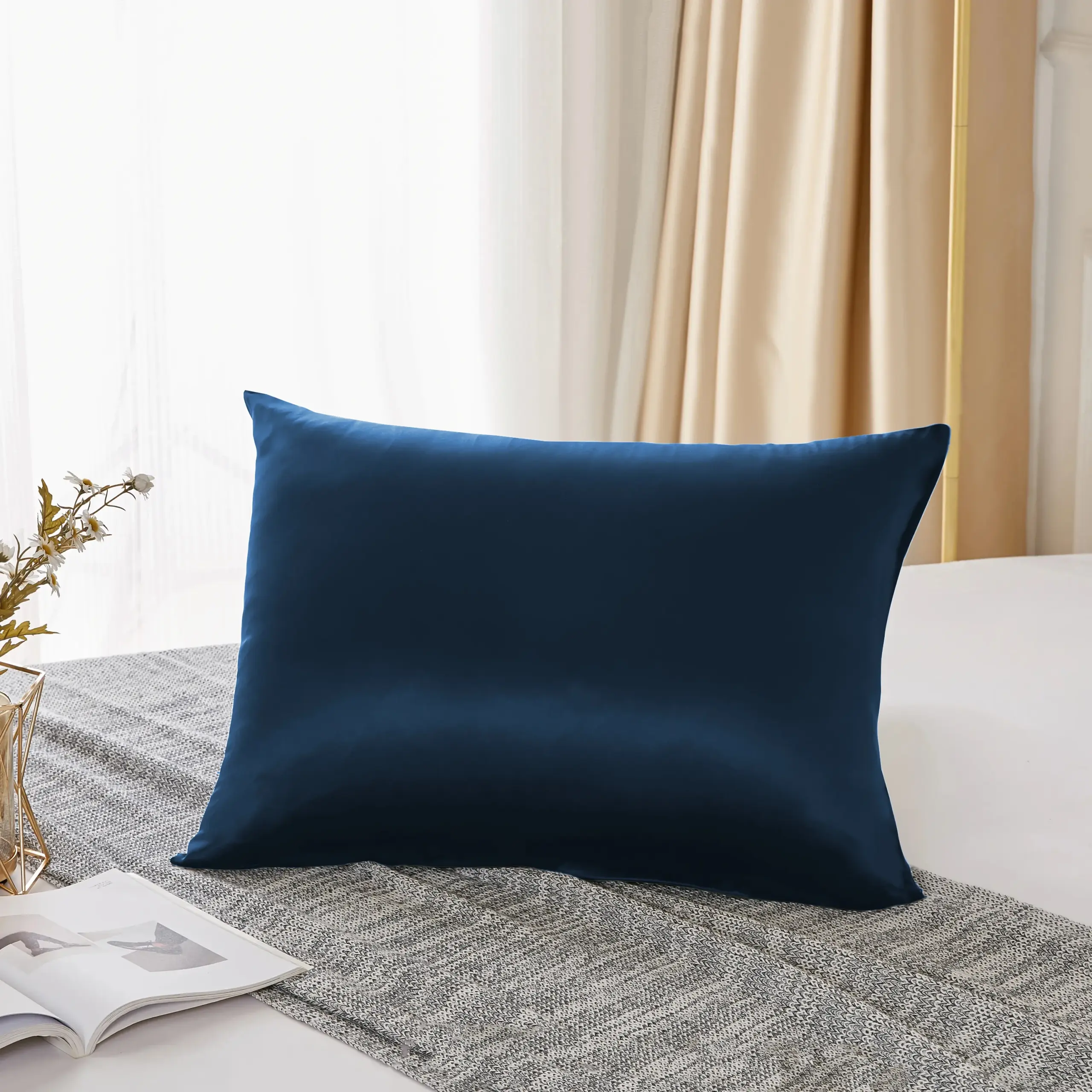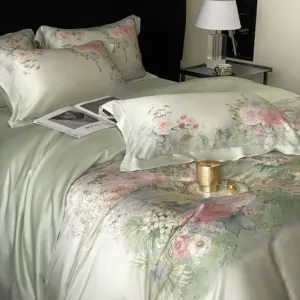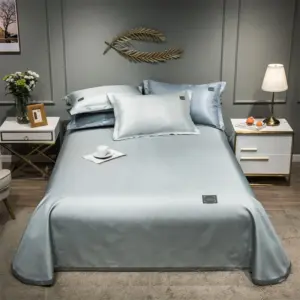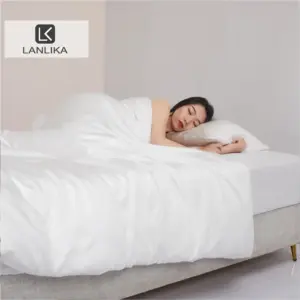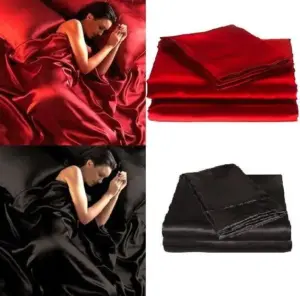Quick Comparison: Silk vs. Cotton Pillowcases at a Glance
When choosing bedding materials, the debate between silk and cotton often leaves shoppers confused about which option truly delivers the best sleep experience. Understanding the amazing benefits of Mulberry silk sheets can help guide your decision, but let’s first compare these popular fabrics across key categories:
| Feature | Silk | Cotton |
|---|---|---|
| Skin Benefits | ★★★★★ Reduces friction, prevents wrinkles, maintains skin moisture | ★★★ Breathable but absorbs moisture and creates friction |
| Hair Benefits | ★★★★★ Prevents frizz, breakage, and bedhead | ★★ Causes friction and potential damage |
| Temperature Regulation | ★★★★★ Natural thermoregulation, cooling and warming | ★★★ Good breathability but retains heat and moisture |
| Comfort & Feel | ★★★★★ Luxurious, smooth, lightweight | ★★★★ Soft, familiar, varies by weave |
| Durability & Care | ★★★ Delicate but long-lasting with proper care | ★★★★ Easy care, machine washable |
| Cost | ★★ Higher investment | ★★★★ Generally affordable |
| Hypoallergenic Properties | ★★★★★ Naturally resistant to allergens and dust mites | ★★ Can harbor allergens without frequent washing |
Looking for options? Browse our collection of premium silk pillowcases designed to enhance your sleeping experience.
The Science Behind Fabric Properties: What Makes Silk and Cotton Different?
To understand why silk and cotton perform differently as bedding materials, we need to explore their fundamental structures. The distinct properties of each fabric stem from their unique origins and composition.
Silk’s Natural Structure
Silk comes from the cocoons of silkworms, specifically the Bombyx mori moth. The fiber consists primarily of a protein called fibroin, giving silk its distinctive properties. This protein structure creates incredibly smooth, continuous filaments that can extend hundreds of yards in length.
The protein composition of silk shares similarities with human hair and skin, containing 18 amino acids that contribute to its gentle interaction with our bodies. Understanding what makes Mulberry silk special reveals why this particular variety stands out from other silk types—the silkworms are fed exclusively on mulberry leaves, producing exceptionally fine and uniform fibers.
Cotton’s Plant-Based Composition
Cotton, by contrast, is a plant-based fiber made primarily of cellulose. Cotton fibers grow as protective cases around the seeds of cotton plants, forming short, fluffy staple fibers rather than continuous filaments. Under a microscope, cotton fibers appear as flat, twisted ribbons with natural irregularities.
This cellulose structure gives cotton its characteristic properties: high absorbency, breathability, and a tendency to wrinkle. The plant origin also explains why cotton feels cool initially but can trap moisture and heat over time.
These fundamental structural differences explain why these fabrics interact differently with our skin, hair, and body temperature during sleep—setting the stage for the specific benefits we’ll explore next.
Skin Health Benefits: How Each Fabric Affects Your Complexion
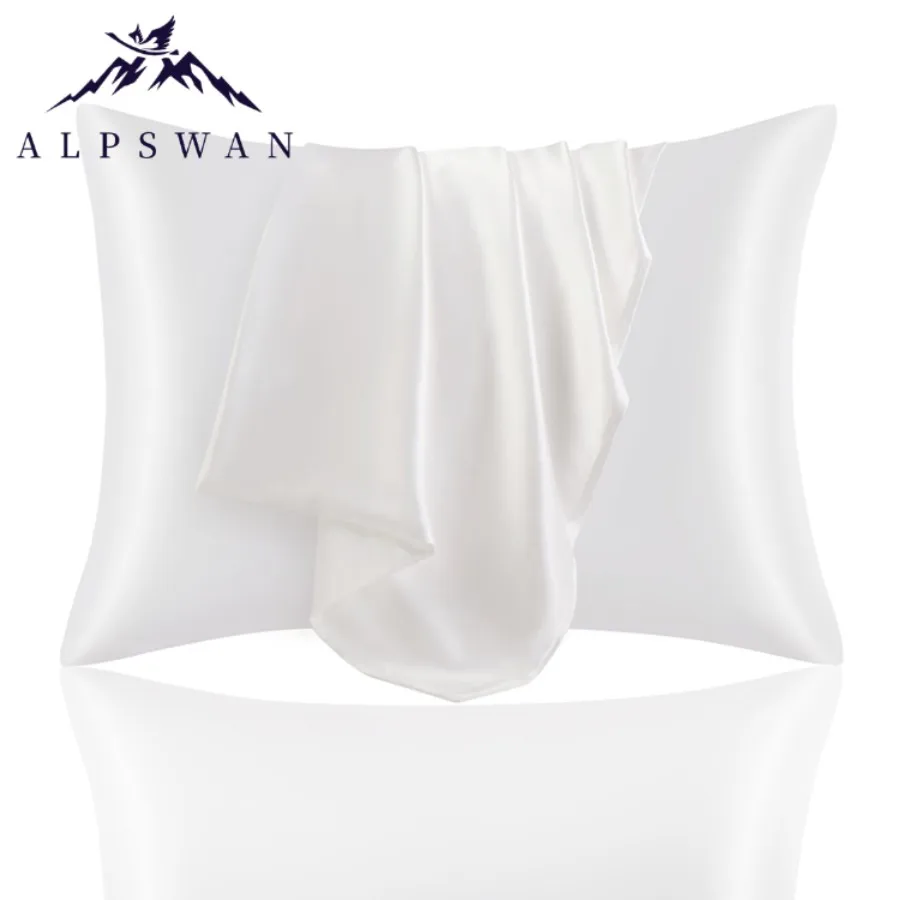
Silk’s Superior Skin Benefits
Silk offers remarkable advantages for skin health that have made it a favorite among dermatologists and skincare enthusiasts alike. The incredibly smooth surface of silk creates minimal friction against your skin, significantly reducing the formation of sleep wrinkles and creases that can become permanent over time.
Unlike cotton, silk doesn’t absorb your skin’s natural moisture or expensive nighttime skincare products. The Mulberry silk bedding skin benefits are particularly notable for people with dry or mature skin, as the fabric helps maintain optimal hydration levels throughout the night.
Silk’s natural properties make it inherently hypoallergenic and resistant to dust mites, mold, and other allergens. This makes silk an excellent choice for those with sensitive or reactive skin conditions like eczema, rosacea, or acne. The protein structure of silk also contains those 18 amino acids that can have a soothing effect on irritated skin.
Cotton’s Effect on Skin
Cotton pillowcases, while comfortable, create more friction against your skin as you move during sleep. This friction can lead to creasing and potential long-term wrinkle formation. The fabric’s absorbent nature also draws moisture away from your skin, which can exacerbate dryness issues overnight.
For those with acne-prone skin, cotton’s tendency to trap sweat, oils, and bacteria can potentially trigger breakouts unless pillowcases are changed very frequently. However, high-quality, tightly woven cotton can still provide a gentle surface for many sleepers without specific skin concerns.
For those with skin sensitivities, our Mulberry silk pillowcases provide an excellent solution to help maintain skin health while you sleep.
Hair Health Comparison: Preventing Damage and Maintaining Style
The fabric you rest your head on nightly significantly impacts your hair’s health, appearance, and style longevity.
Silk’s Hair-Preserving Properties
Silk’s smooth surface creates minimal friction against hair strands, helping to prevent the breakage, split ends, and frizz that rougher fabrics can cause. This reduced friction is particularly beneficial for:
- Curly hair: Preserves curl pattern and reduces frizz
- Fine or brittle hair: Minimizes breakage and thinning
- Color-treated hair: Helps maintain color vibrancy
- Styled hair: Extends the life of blowouts and other styling
Additionally, silk doesn’t absorb hair’s natural oils the way cotton does. This helps maintain your hair’s natural moisture balance, preventing the dryness that can lead to breakage and dull appearance.
Many people who sleep on silk report waking with smoother, more manageable hair that requires less styling time in the morning—a benefit particularly appreciated by those with textured hair.
Cotton’s Impact on Hair
Cotton’s more textured surface creates friction as you move during sleep, which can cause hair to tangle and break. The fabric’s absorbent nature also draws out natural oils from hair, potentially leaving it drier and more prone to damage.
For those with especially delicate hair or who invest significant time in hairstyling, cotton pillowcases may work against their hair health goals. However, cotton does offer breathability that some find comfortable, especially those with very oily hair.
People with sensitivities should consider how Mulberry silk sheets benefit sensitive skin and hair, providing a gentle sleep environment that minimizes irritation and damage.
Temperature Regulation and Sleep Quality: Which Fabric Keeps You Comfortable?
Sleep quality depends significantly on maintaining optimal body temperature throughout the night. How do silk and cotton compare in this crucial aspect?
Silk’s Temperature-Regulating Magic
Silk possesses remarkable natural thermoregulation properties that help maintain comfortable body temperature regardless of the season. In a comprehensive silk vs cotton bedding comparison, silk consistently outperforms in temperature management for several reasons:
- In warm weather, silk stays cool to the touch and efficiently wicks moisture away from the body without absorbing it, helping prevent the clammy feeling that can disrupt sleep
- During colder months, silk creates a thin insulating layer that helps retain body heat without overheating
- Silk’s moisture-wicking properties help evaporate perspiration without feeling wet, making it ideal for those who experience night sweats
This natural temperature adaptability makes silk an excellent year-round bedding option, especially for those who tend to sleep hot or experience temperature fluctuations during the night.
Cotton’s Breathability Factors
Cotton’s primary temperature benefit is its breathability. Air circulates well through cotton fibers, which helps with initial cooling. However, cotton has significant limitations:
- It absorbs moisture rather than wicking it away, which can leave sheets feeling damp and clammy when you sweat
- Once wet, cotton loses its insulating properties and can make you feel cold
- Different cotton weaves perform differently: percale tends to sleep cooler while sateen retains more heat
For those who prioritize temperature regulation, our cooling silk sheets offer superior comfort throughout changing seasons.
Tactile Experience: Comparing the Feel and Comfort of Each Fabric
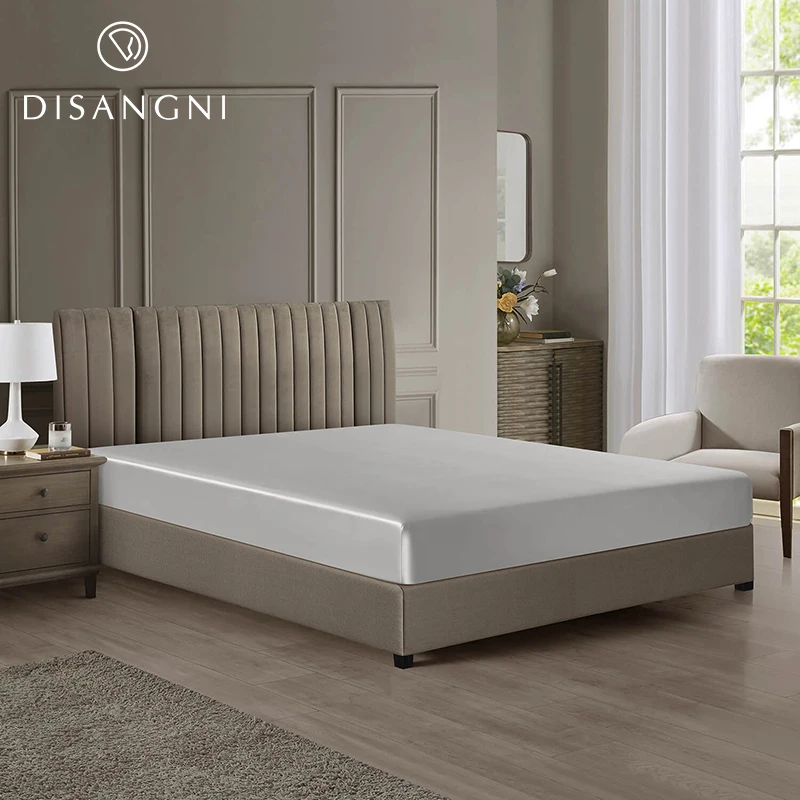
The sensory experience of bedding plays a crucial role in sleep quality and overall satisfaction with your bedroom environment.
Silk’s Luxurious Sensory Experience
Sleeping on silk offers a distinctive tactile experience often described as “floating” on fabric. The material glides smoothly against skin with minimal resistance, creating a light, almost ethereal sensation. The weight of silk bedding, measured in momme, affects this experience:
- 19 momme silk feels lightweight and fluid
- 22 momme offers a perfect balance of lightness and substance
- 25 momme provides a slightly more substantial feel while maintaining silk’s characteristic smoothness
Many users describe silk’s touch as both cooling and comforting simultaneously. The fabric adjusts quickly to body temperature, never feeling too cold or too warm against the skin. This responsive quality contributes to silk’s reputation for luxurious comfort.
Cotton’s Familiar Comfort
Cotton offers a more familiar tactile experience with considerable variation depending on the specific type:
- Percale cotton provides a crisp, cool feel similar to a freshly ironed shirt
- Sateen cotton feels smoother and slightly warmer against the skin
- Jersey cotton has a soft, t-shirt like quality
- Flannel cotton offers cozy warmth with a slightly brushed texture
Cotton typically requires a “breaking-in” period, gradually softening with each wash. While it doesn’t offer the immediate luxurious smoothness of silk, many people appreciate cotton’s substantial, grounded feel.
Experience the unmatched comfort of our premium Mulberry silk sheets and transform your sleep environment.
Durability, Maintenance, and Care Requirements
Making an informed decision between silk and cotton requires understanding the care each fabric demands and how long it will maintain its quality.
Silk Care and Longevity
Contrary to common belief, silk is surprisingly durable when properly maintained. With appropriate care, high-quality silk bedding can last for many years, often outlasting cotton alternatives. Key silk care requirements include:
- Hand washing or machine washing on a gentle cycle in cold water
- Using pH-neutral, silk-specific detergents (regular detergents can damage silk fibers)
- Air drying away from direct sunlight or tumble drying on the lowest heat setting
- Storing in a cool, dry place away from direct sunlight
While these care requirements may seem demanding, they become simple routine practices for silk owners. The complete guide to Mulberry silk bed sheets provides detailed care instructions to maximize the lifespan of your investment.
Cotton Care and Durability
Cotton’s main advantage is its straightforward care routine:
- Machine washable on regular cycles with standard detergents
- Can withstand warmer water temperatures
- Tumble drying on medium to high heat
- Tolerates most cleaning products, including bleach for white cotton
However, cotton typically shows wear more quickly than silk, with signs like pilling, thinning, and color fading appearing after regular washing. Cotton sheets often need replacement every 2-3 years, while well-maintained silk can last significantly longer.
Investment Analysis: Cost Comparison and Long-Term Value
Understanding the true value of bedding materials requires looking beyond initial price tags to consider longevity and benefits over time.
Silk as an Investment
Quality silk bedding represents a higher upfront investment, with prices typically reflecting:
- Material quality (grade of silk used)
- Momme weight (higher momme generally costs more)
- Production methods and ethical considerations
- Brand and certifications
However, when considering cost-per-use, silk often provides excellent long-term value. With proper care, premium silk bedding can last 5-10 years or more, significantly longer than most cotton alternatives. Additionally, the skin and hair benefits may reduce the need for certain beauty products and treatments, creating indirect savings.
Cotton’s Economic Considerations
Cotton bedding offers a wider price range:
- Budget options start quite affordably
- Mid-range cotton provides good quality at moderate prices
- Premium cotton (Egyptian, Pima, Supima) commands higher prices approaching silk’s range
While initially more affordable, cotton typically requires more frequent replacement. Higher-quality cotton lasts longer but still generally needs replacement more often than comparable silk items.
For those seeking the best long-term value, our 100% silk sheets provide exceptional durability and comfort that improves with time.
Understanding Quality Markers: What to Look For When Shopping
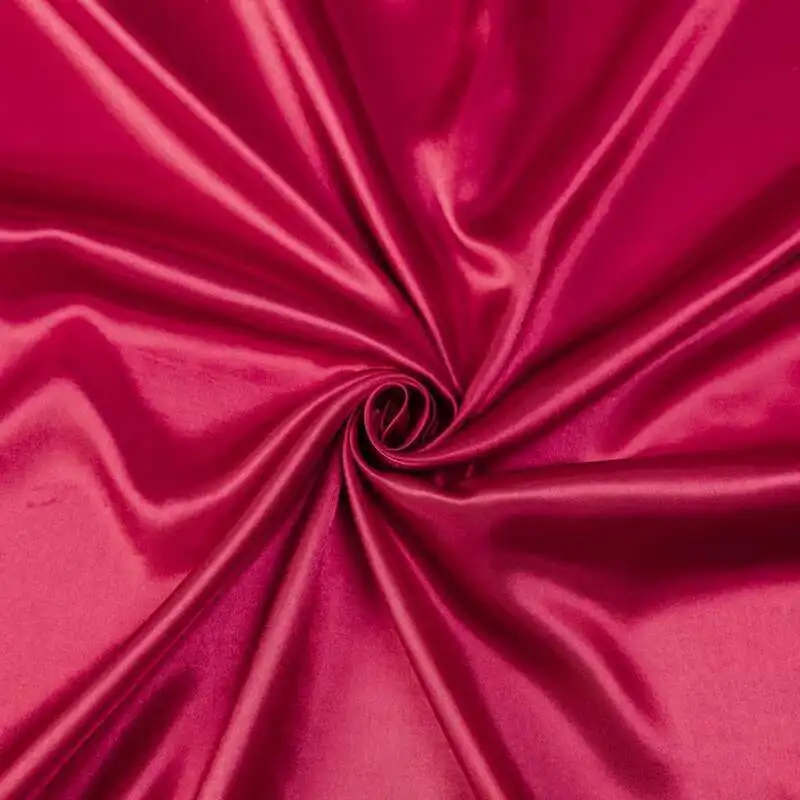
Making an informed purchase requires understanding how to identify quality in both silk and cotton bedding options.
Quality Indicators for Silk
When shopping for silk bedding, look for these key quality markers:
- Mulberry Silk: The highest quality silk comes from Bombyx mori silkworms fed exclusively on mulberry leaves, producing longer, more uniform fibers
- Momme Weight: This measures silk fabric density (similar to thread count). The ideal range is 19-25 momme:
- 19 momme: Lightweight and breathable
- 22 momme: Balanced weight and durability
- 25 momme: Maximum durability while maintaining softness
- Grade: Look for 6A grade, the highest quality designation
- Certifications: OEKO-TEX certification ensures the fabric is free from harmful substances
To distinguish real silk from synthetic alternatives, observe how the fabric feels (cool to touch initially, then warms), how it drapes (fluid and elegant), and how it catches light (subtle, changing sheen rather than static shine).
Quality Markers for Cotton
For cotton bedding, quality indicators include:
- Cotton Type:
- Egyptian cotton: Grown in Egypt’s Nile River Valley with extra-long staple fibers
- Pima/Supima cotton: Long-staple American-grown cotton known for softness and durability
- Standard cotton: Shorter fibers, generally less luxurious
- Thread Count: Measures threads per square inch
- 200-400: Good quality for everyday use
- 400-600: Premium quality with excellent feel
- 600+: Luxury range (though extremely high counts can be misleading)
- Weave Type:
- Percale: Crisp, cool feel with a matte finish
- Sateen: Smoother, silkier finish with a slight sheen
- Flannel: Brushed for warmth and softness
Understanding the differences between thread count vs. momme weight helps shoppers compare fabrics more accurately across categories.
Who Benefits Most? Matching Your Personal Needs to the Right Fabric
Finding your perfect bedding match depends on your specific needs, preferences, and sleep habits.
Ideal Candidates for Silk
Silk bedding provides exceptional benefits for:
- People with curly, fine, or fragile hair prone to breakage and frizz
- Those with sensitive skin conditions like eczema, acne, rosacea, or general sensitivity
- Hot sleepers who struggle with temperature regulation during the night
- Anyone using nighttime skincare products who wants to maximize their effectiveness
- Allergy sufferers seeking naturally hypoallergenic bedding
- Those willing to invest in premium bedding with specialized care requirements
- People who value luxury and sensory comfort in their sleep environment
Ideal Candidates for Cotton
Cotton bedding may be preferable for:
- Budget-conscious shoppers seeking affordable options
- Those who prioritize easy care and maintenance over specialized benefits
- People who prefer a more substantial, weighted feel to their bedding
- Individuals without specific skin or hair concerns
- Those who enjoy the familiar, classic feel of traditional bedding
- People who frequently change or replace their bedding
Understanding how fabric choice can transform sleep quality helps you select bedding that aligns with your personal priorities and wellness goals.
Special Considerations: Allergies, Sensitivities, and Environmental Factors
Beyond comfort and aesthetics, bedding choices can significantly impact health and align with personal values.
Hypoallergenic Properties Compared
Silk offers natural advantages for allergy sufferers:
- Naturally resistant to dust mites, which cannot survive in silk fibers
- Inhospitable to mold and mildew growth due to its moisture-wicking properties
- Contains natural proteins that discourage bacterial growth
- Requires less frequent washing while maintaining hygiene
Cotton, while not inherently hypoallergenic, can be suitable for allergy sufferers when:
– Washed weekly in hot water to remove allergens
– Chosen in tightly woven varieties that create smaller spaces for allergens
– Selected with organic certification to minimize reaction to agricultural chemicals
Environmental and Ethical Considerations
Both silk and cotton production raise important sustainability questions:
Silk production traditionally involves harvesting silk from cocoons, ending the silkworm’s lifecycle. However, peace silk (allowing the moth to emerge) and vegan silk bedding alternatives offer ethical options that maintain similar benefits.
100% Silk Sheets, Green Silk Sheets, King Size Silk Bedding Set, Mulberry Silk Bedding Sets, Queen Size Silk Bedding Set
Price range: $1,246.21 through $1,615.22 Select options This product has multiple variants. The options may be chosen on the product pageEucalyptus Silk Bedding Sets, Eucalyptus Silk Sheets
Price range: $360.24 through $393.60 Select options This product has multiple variants. The options may be chosen on the product page- Price range: $267.82 through $306.55 Select options This product has multiple variants. The options may be chosen on the product page
Bamboo Silk Sheets, Cooling Silk Sheets
Price range: $130.76 through $177.80 Select options This product has multiple variants. The options may be chosen on the product page100% Silk Sheets, King Size Silk Bedding Set, Mulberry Silk Bedding Sets, Queen Size Silk Bedding Set, White Silk Sheets
Price range: $1,000.79 through $1,351.42 Select options This product has multiple variants. The options may be chosen on the product pageBamboo Silk Sheets, Queen Size Silk Fitted Sheet
Price range: $230.24 through $297.88 Select options This product has multiple variants. The options may be chosen on the product page
Cotton farming traditionally uses significant water resources and pesticides, though organic cotton reduces environmental impact. Both materials can be produced with varying degrees of sustainability depending on specific production methods.
For those with chemical sensitivities, certifications like OEKO-TEX Standard 100 ensure bedding is free from harmful substances regardless of material choice.
Frequently Asked Questions About Silk and Cotton Bedding
Can silk pillowcases really reduce wrinkles?
Yes, silk pillowcases can help reduce sleep wrinkles. The smooth surface creates less friction against facial skin, preventing the compression and creasing that can lead to permanent wrinkles over time.
What exactly makes a fabric “breathable”?
Breathability refers to how well air circulates through the fabric. Cotton is naturally breathable due to its fiber structure that allows air to pass between threads. Silk is less porous but wicks moisture away effectively, creating a different type of breathability through moisture management.
Which silk products offer the most beauty benefits?
Silk pillowcases provide the most direct beauty benefits as they come in contact with your hair and face throughout the night. However, full silk sheets extend these benefits to your entire body, potentially reducing overall skin friction and helping to regulate temperature for better sleep quality.
Is higher thread count cotton always better than lower thread count?
Not necessarily. While thread count can indicate quality up to a point (generally 400-600 threads per square inch), extremely high thread counts often use thinner threads or creative counting methods. Fiber quality, weave type, and finish often matter more than thread count alone.
Can silk pillowcases help with acne?
Many users report improvements in acne when switching to silk pillowcases. This may be because silk doesn’t absorb facial oils and products, creates less friction against skin, and harbors fewer bacteria between washings compared to cotton. However, results vary by individual.
Do silk pillowcases need to be replaced as often as cotton ones?
No, high-quality silk pillowcases typically last longer than cotton with proper care. While cotton pillowcases may show wear after 1-2 years of regular use, silk pillowcases can maintain their quality for 3-5+ years when cared for according to manufacturer recommendations.
For more information on making the right choice for your sleep needs, explore why choose Mulberry silk sheets to understand the full range of benefits offered by premium silk bedding options.

